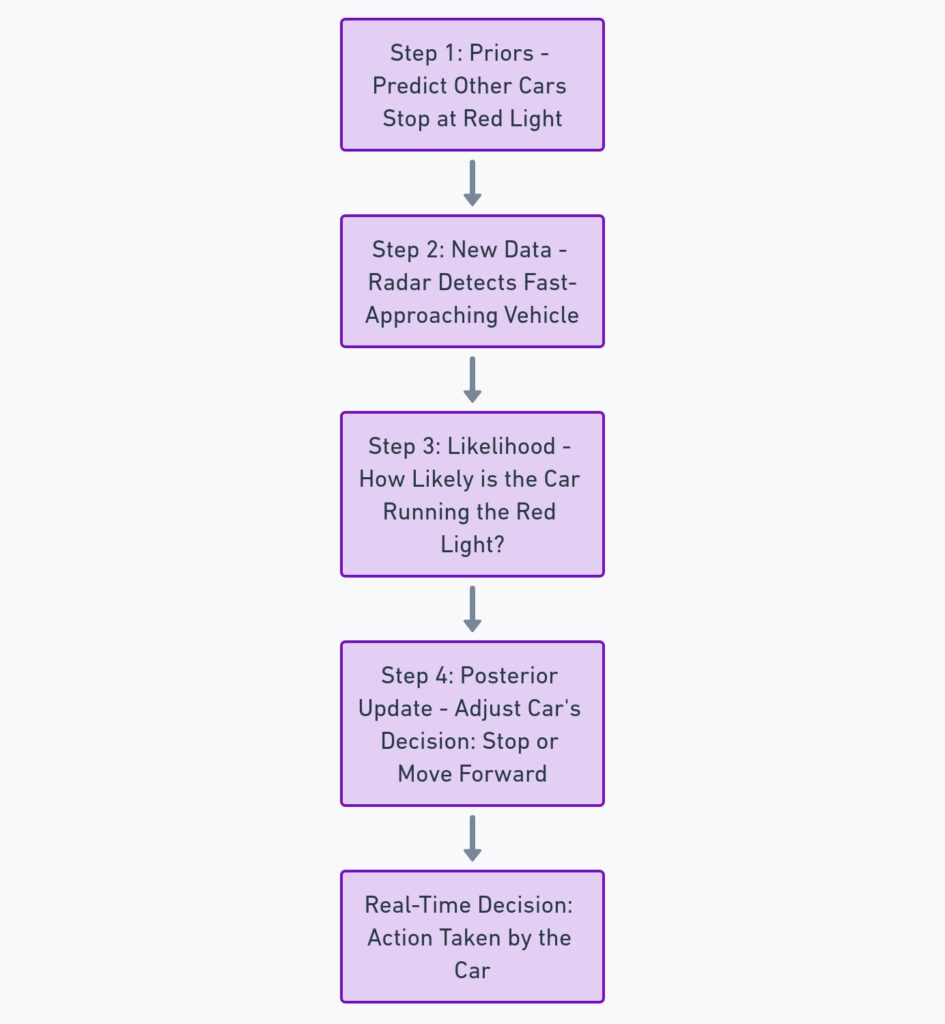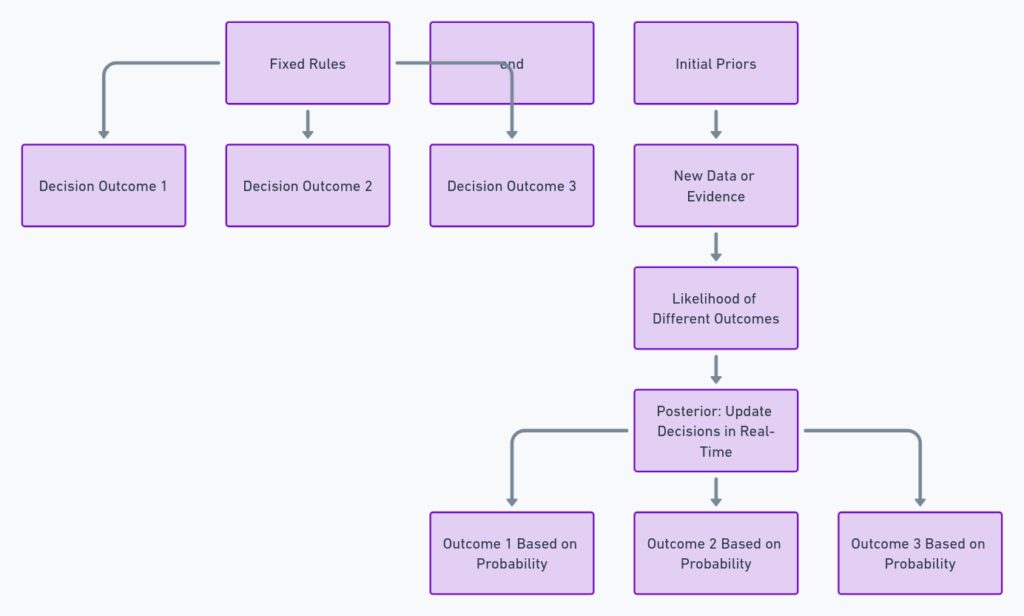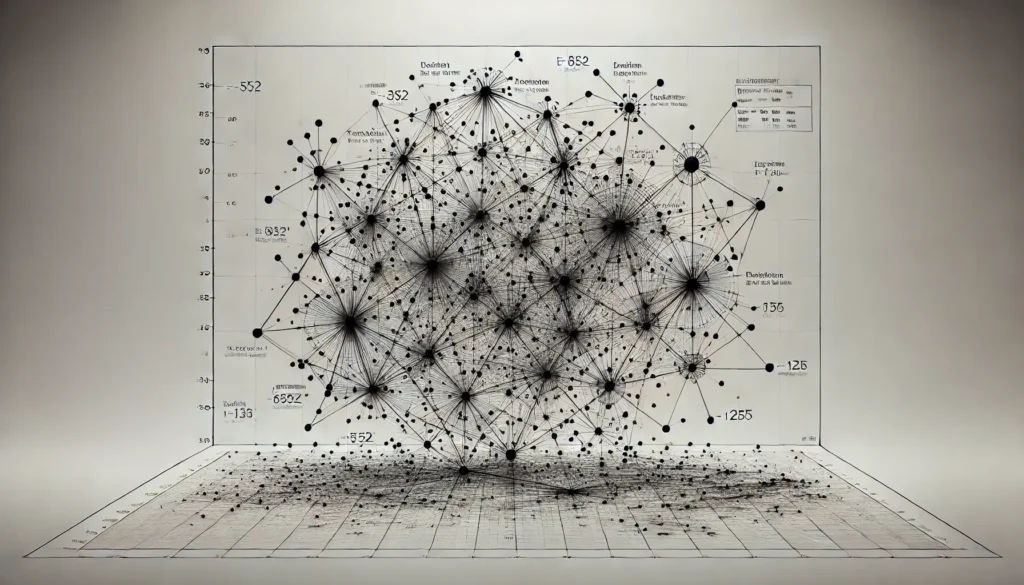
What is Bayesian Inference?
Bayesian inference might sound complicated, but its core concept is quite intuitive. At its heart, it’s about updating beliefs based on evidence.
Picture yourself making a decision when you’re uncertain—you might have some initial belief or guess about the situation (this is your prior knowledge). Then, as new information becomes available, you adjust this belief to better reflect reality.
It works the same way in autonomous systems. These systems use probabilistic reasoning to make sense of ever-changing environments. Bayesian inference provides a mathematical framework to combine prior knowledge and new evidence, leading to decisions that feel “rational.”
When talking about real-time systems, this ability to dynamically update beliefs and respond to new data is essential. As conditions change, Bayesian inference helps these systems make better, more informed decisions.
Why Bayesian Inference Matters in Autonomous Systems
Autonomous systems, from self-driving cars to delivery drones, operate in complex environments. These environments are unpredictable, noisy, and constantly changing. It’s impossible for an autonomous vehicle to have perfect knowledge about the road ahead, the behavior of pedestrians, or even the weather. This is where Bayesian inference shines.
Unlike rule-based systems that can be rigid, Bayesian approaches provide a flexible framework to handle uncertainty. They allow autonomous systems to adapt on the fly, improving their understanding of the world as they gather more data. The ability to update beliefs in real-time is what gives autonomous systems a major advantage when dealing with complex scenarios like traffic or unfamiliar terrain.
Think about how a self-driving car makes decisions. It doesn’t just stick to one possibility—it considers multiple possible outcomes, weighing them according to their probability. If it spots a pedestrian stepping into the road, Bayesian inference helps it quickly decide what’s most likely to happen and respond accordingly.
The Core Components of Bayesian Inference
To understand Bayesian inference in autonomous systems, we first need to break it down into its key components: prior, likelihood, and posterior.
The prior represents the system’s initial understanding of a situation, like the probability that a car will stop at a red light. The likelihood function comes into play when the system collects new data, such as observing that a car is slowing down. Finally, the posterior is the updated belief after incorporating this new evidence.
Together, these components form the backbone of Bayesian reasoning. The system is constantly updating its understanding of the world as it processes new information, which is crucial for making quick decisions. In autonomous systems, this cycle happens in milliseconds, enabling the system to respond almost instantly to changing conditions.
Prior Knowledge: The Foundation of Bayesian Thinking
The prior is where everything begins in Bayesian inference. It’s the system’s initial guess or assumption about the world before it sees any data. In an autonomous vehicle, this could be something as simple as, “Most pedestrians will stop at the curb.” But priors aren’t just wild guesses—they’re often based on past experience or programmed knowledge.

Choosing the right prior is crucial. If the prior is too biased, the system might be slow to update its beliefs when new evidence arrives. On the other hand, a well-calibrated prior can make decision-making faster and more reliable.
For real-time decisions, the system needs to strike a balance between strong priors (which guide the system in the absence of data) and a willingness to update based on new observations. For instance, a drone might assume that most obstacles are stationary, but it needs to be ready to update that belief when it detects a fast-moving object.
The Likelihood Function: Connecting Data to Predictions
Once an autonomous system has its prior, the next step in Bayesian inference is gathering evidence. This is where the likelihood function comes into play. The likelihood function measures how well the new data fits with the current model or understanding of the situation.
Imagine a self-driving car approaching an intersection. Based on its sensors, it sees a car slowing down ahead. The likelihood function calculates the probability that this observation fits with the idea that the car will stop at the red light.
The key here is interpreting data accurately and fast. Autonomous systems rely on a steady stream of data from sensors, cameras, and LIDAR to build a real-time model of their surroundings. The likelihood function allows the system to continuously update its understanding, even when the data is noisy or incomplete.
This constant cycle of updating helps the system make smarter, more informed decisions, improving its performance in dynamic environments.
Real-Time Decision-Making in Autonomous Systems: An Overview
When we think about autonomous systems, we often imagine machines that can handle tasks like driving, flying, or navigating complex environments without human input. But real-time decision-making is the core of what makes these systems effective. Bayesian inference plays a significant role here by allowing these systems to react to new information as it becomes available.

In real-time environments, data is constantly flowing in. Whether it’s from cameras, radar, or other sensors, the system needs to analyze and integrate this data instantly. Bayesian methods help the system quickly interpret new data and make predictions about the future, often in unpredictable and noisy environments. For example, when a self-driving car encounters a sudden obstacle, it has to quickly assess the situation and decide whether to brake, swerve, or continue forward—all within a fraction of a second.
Autonomous systems rely heavily on continuous updates to their decision-making processes. Bayesian inference allows these systems to update their knowledge base dynamically, adjusting their decision paths as they receive new inputs.
How Bayesian Updating Fuels Autonomous Decisions
Bayesian updating is at the heart of how autonomous systems make real-time decisions. Essentially, it’s the process of adjusting probabilities as new data comes in. An autonomous system starts with a prior belief or assumption, then adjusts that belief based on new evidence.

This update process happens rapidly and continuously. For example, in a drone navigating through an urban environment, initial assumptions might suggest that buildings are stationary and cars move predictably. However, as new data streams in—such as detecting a rapidly approaching vehicle—the drone’s Bayesian update process kicks in. It adjusts its assumptions about how quickly vehicles in the area are moving and updates its flight path accordingly.
This is how autonomous systems can stay flexible in highly dynamic environments. Rather than sticking rigidly to pre-programmed rules, Bayesian updating enables a system to adapt its decision-making in real-time based on current conditions.
Bayesian Inference and Machine Learning: A Perfect Pairing

Consider a machine learning model trained to recognize objects on the road—pedestrians, bicycles, cars, etc. While the model can make predictions about what it sees, Bayesian inference adds an additional layer, helping the system assess how confident it is in those predictions. If the model detects an object that’s hard to classify, Bayesian inference will weigh the possible interpretations and select the one with the highest likelihood, based on both the model’s output and the system’s prior knowledge.
This combination is powerful because it enables autonomous systems to make smarter decisions even when the data is incomplete or ambiguous, which is common in real-world environments.
Machine learning and Bayesian inference are a natural pairing in autonomous systems. Machine learning algorithms excel at detecting patterns in large datasets, and when combined with Bayesian inference, they can handle uncertainty much more effectively. While machine learning helps the system “learn” from previous data, Bayesian inference allows the system to make sense of the uncertainty in real-time.
Handling Uncertainty in Real-Time Environments
Uncertainty is inevitable in real-time decision-making for autonomous systems. Whether it’s unpredictable weather, sensor noise, or unexpected human behavior, these systems face countless unknowns. Bayesian inference excels in handling uncertainty by quantifying the likelihood of various outcomes and continuously adjusting predictions based on new data.
In a self-driving car, for instance, sensor readings might fluctuate due to fog, or a pedestrian might behave unpredictably. The system needs to make fast, confident decisions in the face of these uncertainties. By using Bayesian inference, the system can update its beliefs as it collects more data, allowing it to make decisions that balance safety with efficiency.
This approach contrasts with traditional deterministic methods, which might fail in the face of such uncertainty. Bayesian inference gives the system the tools to navigate complex environments safely, even when it can’t be certain about every detail.
Practical Examples of Bayesian Inference in Autonomous Vehicles
One of the most prominent uses of Bayesian inference is in self-driving cars. These cars must navigate a wide range of environments and constantly make decisions about speed, direction, and obstacle avoidance. Bayesian inference is crucial for handling real-time uncertainties.
For example, when a self-driving car approaches an intersection, it needs to predict what other vehicles or pedestrians are likely to do. The system may initially assume that a pedestrian will wait for the green light. However, if the pedestrian starts crossing, the car’s Bayesian model updates its belief, adjusting the likelihood that the pedestrian will stop.
Another example is handling sensor noise. A car’s LIDAR might misinterpret a shadow as an obstacle. Bayesian inference helps filter out such noise by adjusting the system’s confidence in the sensor reading, based on previous observations.
This combination of real-time updates and uncertainty management enables self-driving cars to make safer and more reliable decisions, ensuring smoother rides even in unpredictable traffic environments.
Beyond Vehicles: Other Applications of Bayesian Decision-Making
While autonomous vehicles are a well-known example, Bayesian inference extends far beyond just self-driving cars. In fact, it’s used in various other autonomous systems across different industries. For instance, drones that perform surveillance or package deliveries rely on Bayesian methods to navigate and make real-time decisions about their surroundings.

In industrial settings, autonomous robots use Bayesian inference to optimize tasks like assembly, inspection, or even repair. These robots often work in environments where conditions change rapidly, such as a manufacturing floor. Bayesian decision-making allows them to adapt quickly, ensuring they can still perform their duties efficiently even if their environment changes or if unexpected issues arise.
Medical robots are another exciting application. In surgery, precision is critical, and real-time decisions are made with constantly updating data from sensors and imaging tools. Bayesian methods allow these robots to assess the situation in real-time and adjust their actions for safer and more effective outcomes. This ability to handle uncertainty is what makes Bayesian inference so powerful across such a broad spectrum of autonomous applications.
The Role of Computational Efficiency in Real-Time Bayesian Updates
In real-time systems, speed is critical. Computational efficiency becomes a huge factor in determining how well Bayesian inference can be implemented. Updating beliefs as new data arrives needs to happen incredibly fast, especially when you’re dealing with environments where split-second decisions can be life or death—like in autonomous cars or drones.
Traditional Bayesian methods can be computationally expensive, especially when working with complex models or large datasets. To overcome this, researchers have developed more efficient algorithms and techniques, such as approximate Bayesian computation or sequential Monte Carlo methods. These approaches aim to strike a balance between accuracy and speed, ensuring that autonomous systems can update their beliefs in real time without significant delays.
For example, self-driving cars use optimized Bayesian algorithms to process vast amounts of data from multiple sensors, combining it all to form a coherent understanding of the surrounding environment. This efficiency ensures that decisions like braking, swerving, or accelerating are made promptly, keeping passengers safe and the vehicle on course.
Challenges of Implementing Bayesian Methods in Real-Time
Although Bayesian inference is powerful, it does come with its own set of challenges, particularly when applied to real-time systems. One of the biggest challenges is handling the massive amounts of data that autonomous systems generate. While Bayesian methods are excellent for updating beliefs based on new data, the sheer volume of real-time data can sometimes overwhelm the system.
Another issue is the trade-off between accuracy and speed. In environments where decisions need to be made in milliseconds, such as in autonomous vehicles, there’s often little time to compute exact probabilities. This can lead to approximations that might reduce the accuracy of decisions, especially in highly complex or uncertain environments.
Additionally, integrating Bayesian inference with other technologies like deep learning or reinforcement learning can be complex. While the combination is powerful, getting these systems to work seamlessly together often requires careful tuning and optimization.
Comparing Bayesian Methods with Other Decision-Making Approaches
Bayesian inference is one of many approaches used in autonomous decision-making. Other methods, such as rule-based systems, heuristics, or machine learning algorithms, each have their strengths and weaknesses. However, Bayesian inference stands out because of its ability to handle uncertainty and continuously update as new data becomes available.

Rule-based systems, for instance, can be faster since they follow predefined paths. However, they are often rigid and struggle to adapt in dynamic environments. On the other hand, machine learning systems excel at pattern recognition but can sometimes struggle with uncertainty, particularly when they encounter data that they weren’t trained on.
Bayesian inference, by contrast, excels in scenarios where the system needs to make decisions in uncertain, fast-changing conditions. It allows for a more nuanced approach, balancing the need for flexibility with the ability to weigh evidence as it emerges. This makes it particularly well-suited for real-time decision-making in environments where uncertainty is unavoidable.
Future Trends: Bayesian Inference in Next-Gen Autonomous Systems
The future of Bayesian inference in autonomous systems looks promising as advancements in both hardware and software continue to push boundaries. Quantum computing, for example, could dramatically speed up the complex calculations needed for Bayesian inference, making it possible to handle even more data at faster speeds. This would open up new possibilities in areas like swarm robotics or high-speed autonomous drones, where quick decision-making is crucial.
Moreover, as machine learning algorithms continue to evolve, we’re likely to see tighter integration between Bayesian methods and AI models. This will allow autonomous systems to not only make decisions in real time but also learn from their experiences more efficiently. Such systems could become more adaptive, adjusting their priors based on long-term learning rather than just immediate feedback.
Another area to watch is multi-agent systems, where multiple autonomous entities (like drones or self-driving cars) must work together. Bayesian inference could help these systems share and update their beliefs in real time, improving coordination and decision-making across the entire group.
Ethical Considerations in Autonomous Decisions Using Bayesian Methods
As we rely more on autonomous systems to make decisions, especially in critical areas like transportation and healthcare, ethical concerns are becoming more prominent. Bayesian inference plays a role in how these systems assess risk, prioritize safety, and ultimately make decisions that could affect human lives.
For example, when a self-driving car uses Bayesian methods to decide whether to swerve or brake, it is effectively making a life-or-death decision. The ethical question becomes: how should these probabilities be weighed? Should the system prioritize passenger safety over pedestrian safety? Or vice versa?
Another issue is transparency. Bayesian systems are often seen as “black boxes,” where it’s difficult to understand exactly how decisions are made. As autonomous systems become more widespread, there will be a growing need for more transparency in how Bayesian decisions are formulated, ensuring that they align with ethical standards and societal expectations.
Balancing efficiency, safety, and ethical responsibility will continue to be a major challenge as autonomous systems evolve.
Conclusion: The Power of Bayesian Inference in Real-Time Autonomy
Bayesian inference has become a cornerstone for real-time decision-making in autonomous systems. Its ability to continuously update beliefs based on new data and adapt to uncertain environments makes it uniquely suited for tasks that require quick, flexible thinking. From self-driving cars to medical robots and beyond, Bayesian methods are shaping the future of how machines interact with the world.
As we look to the future, the integration of Bayesian inference with machine learning, advancements in computational power, and greater collaboration between autonomous agents promises to unlock even more sophisticated systems. These systems will not only make decisions faster but also smarter, handling uncertainty with greater ease and precision.
Yet, as we push the boundaries of autonomy, ethical considerations and computational challenges will need to be carefully addressed. Transparency in how autonomous systems make life-impacting decisions will be crucial to ensuring public trust. In the end, the blend of powerful probabilistic models with evolving AI techniques positions Bayesian inference as a fundamental tool for the next generation of autonomous technologies.
Resources
Bayesian Methods for Machine Learning” – Coursera
This Coursera course covers both the theoretical and practical aspects of Bayesian methods, including how they are applied in machine learning and autonomous systems. It’s an excellent resource if you want to understand how Bayesian inference integrates with AI models.
Link to Cousera
“A Tutorial on Bayesian Optimization of Expensive Cost Functions” by Nando de Freitas
This detailed tutorial provides insight into Bayesian optimization, a key application of Bayesian inference in real-time decision-making. It explores probabilistic modeling, Gaussian processes, and optimization techniques that are often used in autonomous systems.
PDF Tutorial
“Probabilistic Robotics” by Sebastian Thrun, Wolfram Burgard, and Dieter Fox
This book is a comprehensive resource on how Bayesian methods are used in robotics for tasks like localization, mapping, and planning. It explains the mathematical foundations of probabilistic reasoning and how autonomous robots handle uncertainty in real time.
“Real-Time Systems” by Jane W. S. Liu
For a broader understanding of real-time decision-making, this book provides a detailed look at the principles and challenges of real-time systems, including computational efficiency, timing constraints, and how algorithms like Bayesian inference can be applied in these contexts.
Link to Book





